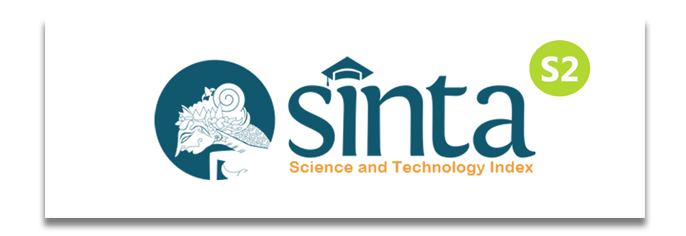In Vitro Comparison of Antifungal Activity between Epigallocatechin Gallate EGCG) and Nystatin on Candida Sp. Stored Isolates in HIV/AIDS Patients with Oral Candidiasis
Downloads
substances as antifungal agents. In this study, Epigallocatechin gallate (EGCG) were examined for in vitro antifungal activity against Candida strains. Purpose: To compare the in vitro antifungal activity of EGCG and nystatin towards Candida sp. isolate in HIV/AIDS patients with oral candidiasis. Methods: This research was an experimental laboratory study conducted at the Dr. Soetomo General Academic Hospital, Surabaya. Forty isolates of Candida albicans and Candida non-albicans were included. The isolates were tested for antifungal activity using the well diffusion and microdilution method for nystatin 1000 IU and EGCG 1.25%. Result: Diffusion test results showed a greater inhibition zone for nystatin against all analyzed Candida strains with an average diameter for Candida albicans formed by EGCG of 2.15 mm and 7.4 mm for Candida non-albicans. Meanwhile, based on the microdilution test, EGCG was better than nystatin towards all analyzed Candida strains. This study showed EGCG Minimum Fungicidal Concentration (MFC) as high as 50% (p < 0.05). Conclusion: Nystatin antifungal activity was better than EGCG supported by a greater inhibition zone in the well diffusion method. However, the antifungal activity of EGCG was better than nystatin based on microdilution methods.
Marak MB, Dhanashree B. Antifungal susceptibility and biofilm production of Candida spp. isolated from clinical samples. Int J Microbiol 2018; 2018(1): 1-5.
Nur'aeny N, Hidayat W, Dewi TS, Herawati E, Wahyuni IS. Profil oral candidiasis di bagian ilmu penyakit mulut RSHS Bandung periode 2010-2014. Majalah Kedokteran Gigi Indonesia 2014; 3(1) :23-8.
Patil S, Majumdar B, Sarode SC, Sarode GS, Awan KH. Oropharyngeal candidosis in HIV-infected patients-an update. Front Microbiol
; 9(1): 1-9.
Cuesta CG, Perez MGS, Bagan JV. Current treatment of oral candidiasis: a literature review. J Clin Exp Dent 2014; 6(5): 576-82.
Warrier SA, Sathasivasubramanian S. Human immunodeficiency virus induced oral candidiasis. J Pharmacy Bioallied Sci 2015; 7(2): 812-4.
Dewi ISL, Hidayati AN. Manifestasi kelainan kulit pada pasien HIV & AIDS. Berkala Ilmu Kesehatan Kulit dan Kelamin 2015; 27(2): 97– 105.
Putranti, A. Oral candidiasis as clinical manifestation of HIV/AIDS infection in Airlangga University hospital patients. IOP Conf. Ser Earth Environ Sc 2018; 125(1): 120-63.
Rahayu RP, Prasetyo RA, Purwanto DA, Kresnoadi U, Iskandar RPD, Rubianto M. The immunomodulatory effect of green tea (camellia sinensis) leaves extract on immunocompromised wistar rats infected candida albicans. Vet World 2018; 11(5): 765-70.
Vila T, Sultan AS, Montelongo-Jauregui D, Jabra-Rizk MA. Oral Candidiasis: A Disease of Opportunity. J Fungi 2020; 6(1): 15
Suyoso S, Ervianti E, Barakbah J. Kandidiasis mukosa. In: Suyoso S, Ervianti E, Barakbah J, editors. Panduan Praktik Klinis SMF Ilmu Kesehatan Kulit dan Kelamin RSUD Dr. Soetomo. Surabaya: RSUD Dr. Soetomo; 2014. p.95–7.
Khalandi H, Masoori L, Farahyar S, Delbandi AA, Raiesi O, Farzanegan A, et al. Antifungal activity of capric acid, nystatin, and fluconazole and their in vitro interactions against candida isolates from neonatal oral thrush. Assay Drug Dev. Technol 2020; 18(3): 1-7.
Moges B, Bitew A, Shewaamare A. Spectrum and the in vitro antifungal susceptibility pattern of yeast isolates in ethiopian HIV patients with oropharyngeal candidiasis. Int J Microbiol 2016;2016(1): 1-8.
Yassin MT, Mostafa AA, Al-Askar AA, Bdeer R. In vitro antifungal resistance profile of candida strains isolated from Saudi women suffering from vulvovaginitis. Eur J Pharm Med Res 2020; 25(1): 1-9.
Madhura MG, Shweta RD, Kumar BV, Savithri D, Gajalakshmi S, Soumya BV. Antifungal effect of green tea extracts on oral candida species: an in vitro study. J. adv. clin. res. insight 2016; 3(1): 1-4.
Matsumoto Y, Kaihatsu K, Nishino K, Ogawa M, Kato N, Yamaguchi A. Antibacterial and antifungal activities of new acylated derivatives of epigallocatechin gallate. Front Microbiol 2012; 3(1): 53-5.
Steinmann J, Buer J, Pietschmann T, Steinmann E. Anti-infective properties of epigallocatechin-3-gallate (EGCG), a component of green tea. Br J Pharmacol 2013; 168(5): 1059–73.
Spalanzani RN, Mattos K, Marques LI, Barros PFD, Pereira PIP, Paniago AMM, et al. Clinical and laboratorial features of oral candidiasis in HIV-positive patients. Rev Soc Bras Med Trop 2018; 51(3): 352-6
Granja A, Frias I, Neves I, Neves AR, Pinheiro M, Reis S. Therapeutic potential of epigallocatechin gallate nanodelivery systems. Hindawi BioMed Res Int 2017; 2017(1): 1-15.
Behbehani JM, Irshad M, Shreaz S, Karched, M.
Synergistic effects of tea polyphenol epigallocatechin 3-O-gallate and azole drugs against oral candida isolates. J Mycol Méd 2019; 29(2): 158-67.
Scorzoni L, Benaducci T, Almeida AMF, Silva DHS, Bolzani VS, Gianinni MJSM. The use of standard methodology for determination of antifungal activity of natural products against medical yeasts candida sp and cryptococcus sp. Brazilian J Microbiol 2007; 38(1): 391-7.
Balouiri M, Sadiki M, Ibnsouda SK. Methods for in vitro evaluating antimicrobial activity: A review. J Pharm Anal 2016; 6(2): 71-9.
Khan ZA, Siddiqui ME, Park S. Current and Emerging Methods of Antibiotic Susceptibility Testing. Diagnostics 2019; 9(2): 49
Copyright (c) 2021 Berkala Ilmu Kesehatan Kulit dan Kelamin

This work is licensed under a Creative Commons Attribution-NonCommercial-ShareAlike 4.0 International License.
- Copyright of the article is transferred to the journal, by the knowledge of the author, whilst the moral right of the publication belongs to the author.
- The legal formal aspect of journal publication accessibility refers to Creative Commons Atribusi-Non Commercial-Share alike (CC BY-NC-SA), (https://creativecommons.org/licenses/by-nc-sa/4.0/)
- The articles published in the journal are open access and can be used for non-commercial purposes. Other than the aims mentioned above, the editorial board is not responsible for copyright violation
The manuscript authentic and copyright statement submission can be downloaded ON THIS FORM.















